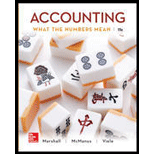
Concept explainers
Sub Part-1
Income Statement:
The Operating income of the business is the income generated from the main operations of the business. This includes expenses such as cost of goods sold, selling expense and admin expenses. But does not include expenses like Loss on sale of assets, interest charges and also does not include the non-operating incomes like gain on sale of assets, interest revenue, etc.
The Net income is computed by deducting the non-operating expense and adding up non-operating incomes in the net operating incomes of the year. After making the above adjustment, the income tax expense has been deducted to arrive at the net income earned for the year.
The Retained earnings at the end of the year shall be computed by adding the net income for the year in the beginning balance and then deducting the dividend paid during the year.
The balance sheet of the firm is prepared by listing all the assets on one hand and all the liabilities and
The amount of difference between current assets and current liabilities.
Sub Part-2
Average Income Tax rate:
The Average Income Tax rate is computed by dividing the income tax expense paid during the year with the pre-tax income computed, as expressed in terms of percentage.
The average income tax rate for income tax paid for the year.
Sub Part-3
The Interest rate charged on Long term debts.
Sub Part-4
The par value per share shall be computed.
Sub Part-5
The dividend payout policy of the company.
Want to see the full answer?
Check out a sample textbook solution
Chapter 2 Solutions
Accounting: What the Numbers Mean
- Please explain the solution to this general accounting problem with accurate principles.arrow_forwardPlease explain the solution to this general accounting problem with accurate principles.arrow_forwardPlease provide the answer to this general accounting question using the right approach.arrow_forward
- Please help me solve this general accounting question using the right accounting principles.arrow_forwardCan you solve this financial accounting question with accurate accounting calculations?arrow_forwardI am trying to find the accurate solution to this general accounting problem with the correct explanation.arrow_forward
- I am looking for the correct answer to this general accounting question with appropriate explanations.arrow_forwardPlease explain the correct approach for solving this financial accounting question.arrow_forwardCan you explain the correct methodology to solve this general accounting problem?arrow_forward
- I need help finding the accurate solution to this general accounting problem with valid methods.arrow_forwardI am searching for the accurate solution to this general accounting problem with the right approach.arrow_forwardI need assistance with this financial accounting question using appropriate principles.arrow_forward

 AccountingAccountingISBN:9781337272094Author:WARREN, Carl S., Reeve, James M., Duchac, Jonathan E.Publisher:Cengage Learning,
AccountingAccountingISBN:9781337272094Author:WARREN, Carl S., Reeve, James M., Duchac, Jonathan E.Publisher:Cengage Learning, Accounting Information SystemsAccountingISBN:9781337619202Author:Hall, James A.Publisher:Cengage Learning,
Accounting Information SystemsAccountingISBN:9781337619202Author:Hall, James A.Publisher:Cengage Learning, Horngren's Cost Accounting: A Managerial Emphasis...AccountingISBN:9780134475585Author:Srikant M. Datar, Madhav V. RajanPublisher:PEARSON
Horngren's Cost Accounting: A Managerial Emphasis...AccountingISBN:9780134475585Author:Srikant M. Datar, Madhav V. RajanPublisher:PEARSON Intermediate AccountingAccountingISBN:9781259722660Author:J. David Spiceland, Mark W. Nelson, Wayne M ThomasPublisher:McGraw-Hill Education
Intermediate AccountingAccountingISBN:9781259722660Author:J. David Spiceland, Mark W. Nelson, Wayne M ThomasPublisher:McGraw-Hill Education Financial and Managerial AccountingAccountingISBN:9781259726705Author:John J Wild, Ken W. Shaw, Barbara Chiappetta Fundamental Accounting PrinciplesPublisher:McGraw-Hill Education
Financial and Managerial AccountingAccountingISBN:9781259726705Author:John J Wild, Ken W. Shaw, Barbara Chiappetta Fundamental Accounting PrinciplesPublisher:McGraw-Hill Education





